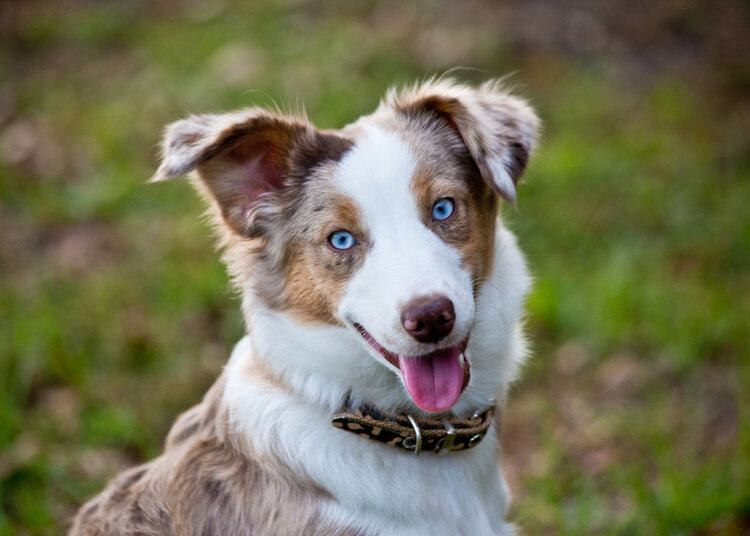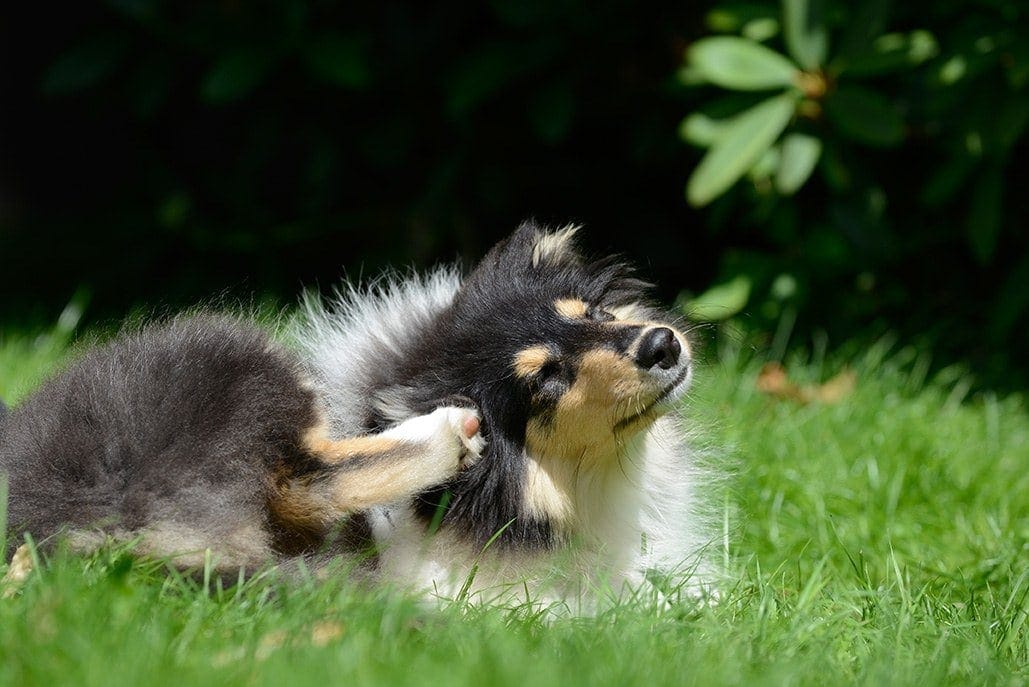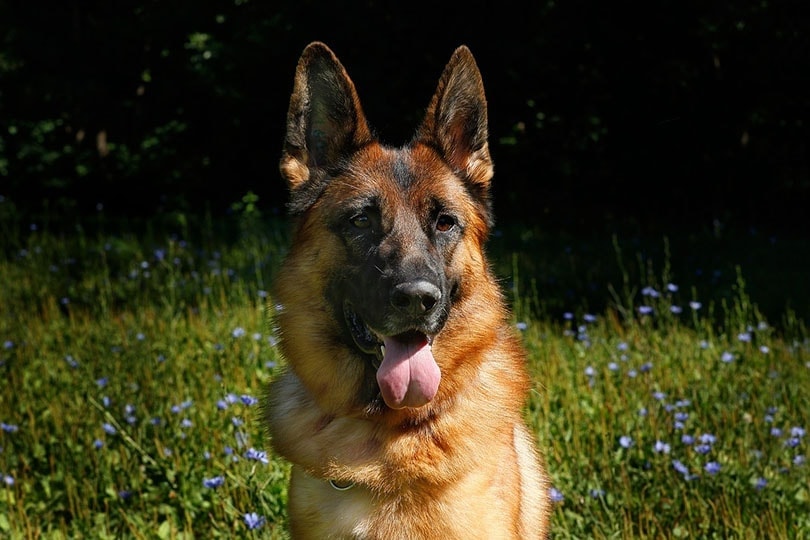There is no denying that blue eyes in a dog are one of the most attractive colors they could have. While blue eyes are uncommon in humans, making up only 10% of the population, it’s even more of a rarity in dogs. Blue eyes in dogs may be beautiful, but it can also be a link to health issues such as deafness and blindness. In addition, it can also be strictly due to a rare genetic combination and specific coat patterns.
One thing is for sure, it’s a captivating contrast against virtually any coat variety. Let’s see the top seven lovely dogs who are lucky enough to carry this gene!
1. Siberian Husky
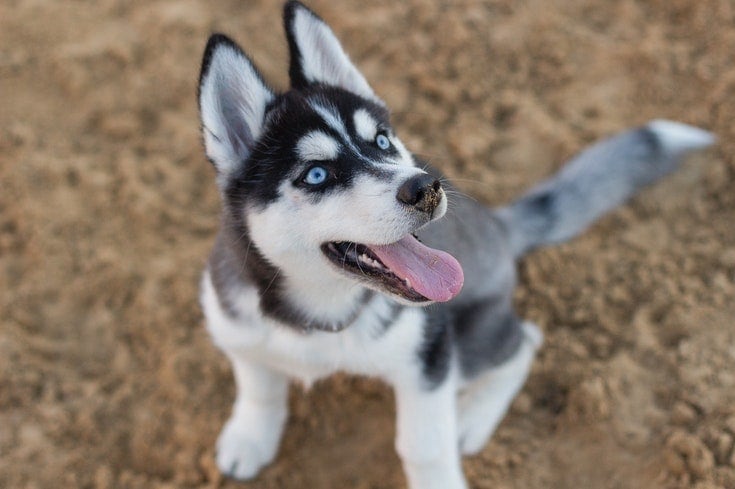
These stunningly beautiful snow dogs are well-known and sought after because of their icy blue eyes. In fact, when you think of blue-eyed canines, they’re probably the first ones that come to mind. They may commonly have two blue eyes, or only one. The color is a product of a rare gene passed on throughout generational breeding.
These medium-sized pups are equally popular in cold and hot climates, but they were initially in Siberia, as the name implies. They came to Alaska in 1908 to engage in sled-dog racing and have grown within America ever since. You can find a husky just about anywhere these days. So, if you opt for one, make sure to get them from a reputable person to avoid bad traits in the bloodline.
Because they are bred for working purposes, they tend to get very bored if they don’t have proper stimulation. They make magnificent companion animals for active lifestyles. If you don’t want to participate, look out! They just may decide to go on an adventure without you. They can also tear up just about anything with that nice dental palette when you aren’t around. Playtime is a must.
2. Australian Shepherd
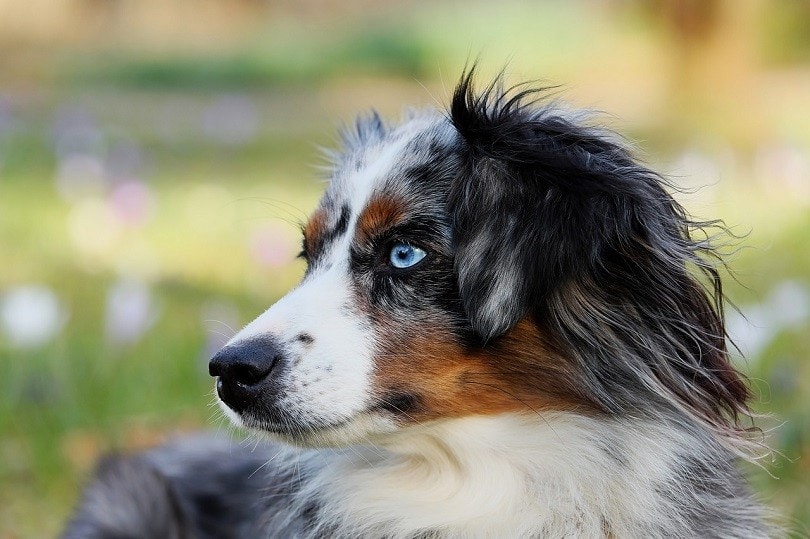
This friendly, unique breed is another in which the blue color frequently shows up. These incredibly intelligent dogs are not only the holders of this beautiful color, but they may have some of the most interesting colors of all breeds. They can vary from green, marble, hazel, and brown. And, who knows, you may get two different colors.
These dogs were used for herding purposes and are insanely smart and easy to train. They love to work so much that they won’t know what to do without having a task. So, if you opt for this breed, make sure you give them a wide variety of mental and physical stimuli. If you aren’t a person who has patience and a very active lifestyle, this dog isn’t for you. They need plenty of room to run and things to do.
This breed nips at the heels, which you can correct with early training. It’s kind of cute that they try to herd their owners, but you must address it. So that your dog knows you are the master, and they don’t need to keep you in line, a respectful hierarchy needs to be taught to these adorable dogs early in life.
3. Weimaraner
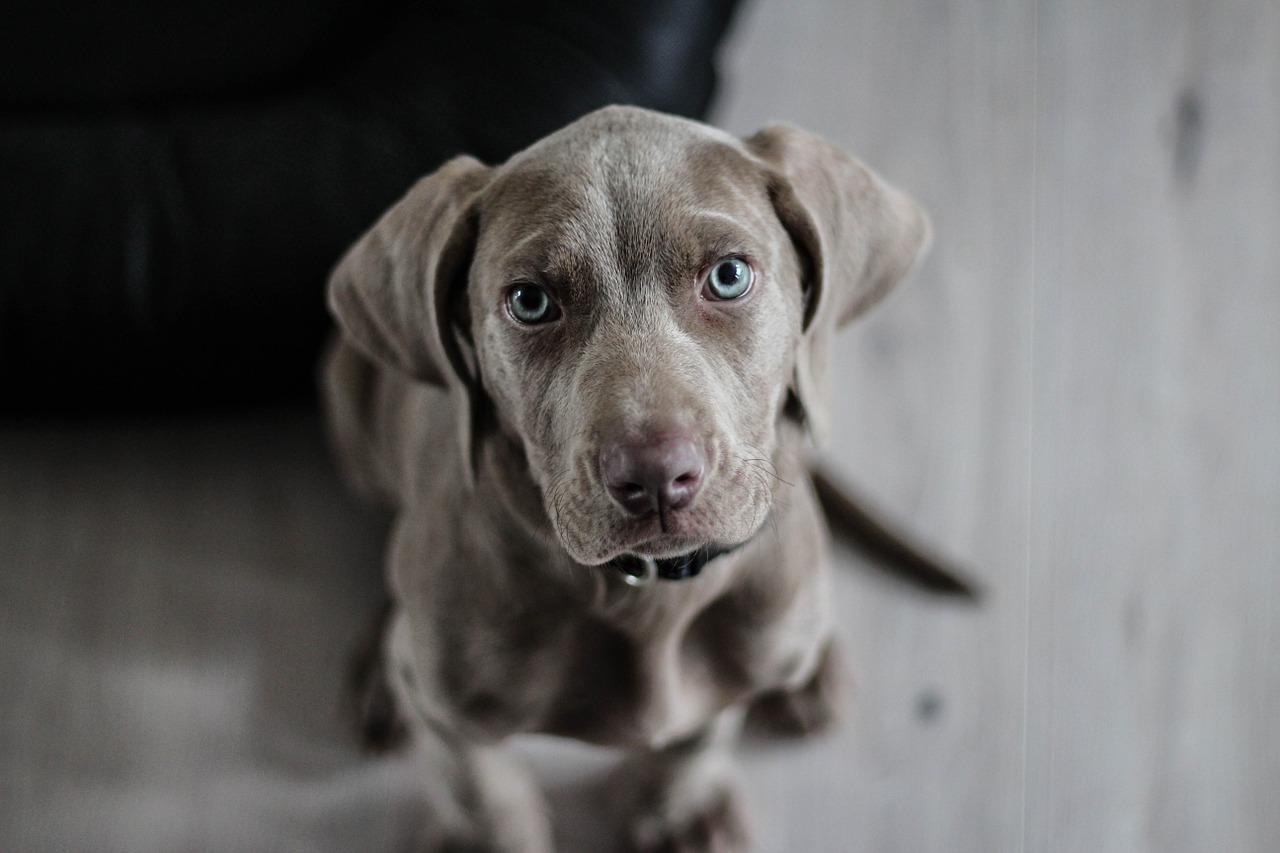
This breed is a gorgeous gray-blue color, and their eyes follow suit. Typically, when they are puppies, their eyes are a bright ice blue, but they tame down as they age. Some of them may even turn amber. Most commonly, however, they do remain a shade of hazy blue, often mimicking their fur.
These dogs were originally bred for hunting larger game such as deer and boar. They are highly agile and very physically driven. They may also exhibit some aggression toward other dogs of the same gender, as they take dominance very seriously. If they undergo proper socialization or grow up with other dogs, this will probably work out.
With their families, Weimaraners tend to be incredibly kind, protective, and trainable. However, when it comes to strangers or smaller animals, they may not do so well. They have a wildly high prey drive and can chase, attack, and even kill if they get the inkling. While training is a good stepping stone, most prey drives cannot be trained out of a dog, so they may be best for an only-dog household.
4. Dalmatian
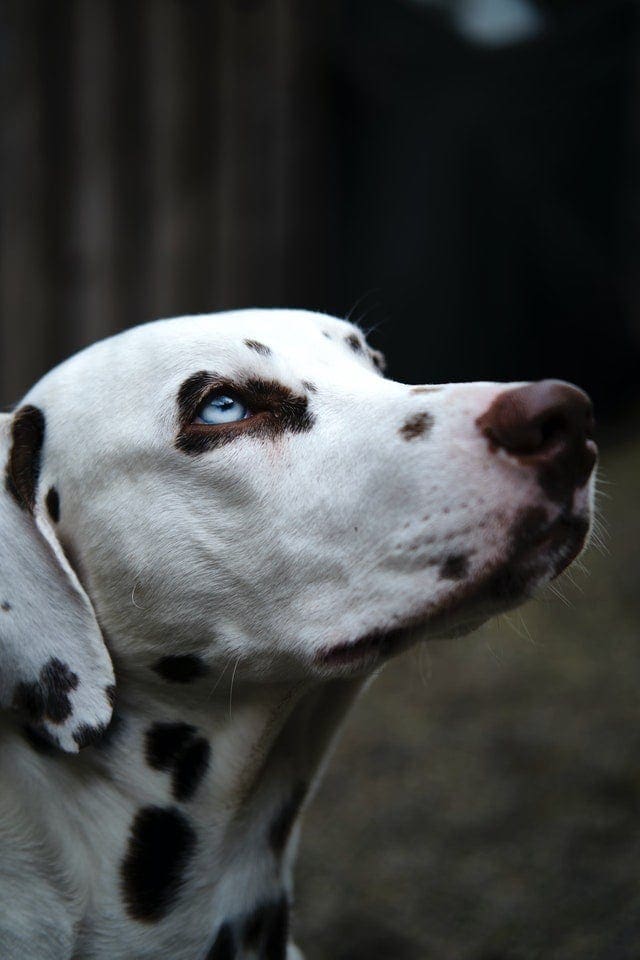
Dalmatians have made quite an impact on the general population over the past several generations. They are notorious for being big helpers at firehouses. Disney, of course, really heightened their popularity by making them stars in 101 Dalmatians. This has made them a fad dog, which isn’t necessarily the best thing for the breed since it led to homeless dogs and problems in the bloodlines because of overbreeding.
In addition to their work roles, their adorable markings have made them much sought after dogs. Most dalmatians are prone to deafness. It’s reported that up to 30% of Dalmatians show hearing loss in one or both ears. While the blue eyes don’t always indicate hearing issues, they can be your first clue. Having their hearing evaluated by a veterinarian can help you accommodate them.
Deafness is definitely manageable, but being very well-educated about it can only help you to assist your pet. Because of their popularity, many people purchase dalmatians without proper knowledge of the breed—which has led to poor specimens as a consequence. These dogs are highly energetic and must have adequate stimulation. Research is key to ensure the best fit for your household.
5. Cardigan Welsh Corgi
These adorable little sweethearts can also have blue eyes. It most commonly seen in the merle coats and is otherwise considered a flaw in the breed. Corgis are sometimes seen with only one blue eye as well. This trait makes your little one even more loveable, but most breeders will highly advise you not to allow your blue-eyed Corgi to reproduce and encourage you to spay or neuter as soon as possible.
This breed is a fan-favorite these days. They are curious, fun-loving, and cuddly. They originated in Wales as herding dogs and have come a long way since. Their over-sized ears, friendly expressions, and stubby legs make them irresistibly cute, and they have the personality to back it up.
Don’t go racing out to get a Corgi under the false assumption you’ll find one with blue eyes. This trait is rare. It’s best to buy Corgi’s because they are vigorous, friendly, and a ton of fun to play with. If you get one with blue eyes, consider this just an added perk for your personal preference.
6. Great Dane

These gentle giants are a sight to behold no matter their eye color. However, Danes have a rather unique pattern known as Harlequin. Within this coat pattern, blue eyes are very plentiful. This may affect one or both eyes. The contrast is lovely against the gray and black hues of the fur.
Despite their size, a Dane looks reasonably friendly, and they typically are. Ear cropping is a procedure sometimes seen in this breed. This can make them look much more aloof, serious, even aggressive. But their good nature and kind hearts will shine through even the toughest exteriors.
Zeus was a Great Dane who still holds the title of the world’s largest dog, measuring over 44 inches tall. They are also called the Apollo of Dogs, named after the Greek God. While large, these dogs usually don’t know their size. It isn’t uncommon to see one try to crawl into your lap, even though they’d never fit. They have lovely temperaments. With patience and proper training, make delightful pets.
7. French Bulldogs

Traditionally, Frenchie’s don’t carry the blue-eye gene. However, because of their coat variations, blue does enter the color possibilities for this adorable little bat-eared dog. Blue can show up due to coat color and is frequently seen in fawn and merle variations. It is also seen sometimes in blue French bulldogs, which may be the most beautiful of all.
It may be hard to tell, however, if their eyes will stay this color. French Bulldogs are born with blue eyes, which change around ten weeks of age. To be sure they won’t change, purchasing a puppy beyond this age will increase your chances. So, remember when you are buying from a reputable breeder, check for the age to ensure no changes or surprises happen.
When it comes to a spunky companion who loves everyone they encounter, the Frenchie is a front runner. They are known for their larger than life personalities and amiable nature. They don’t get very big, either. Since they top out at 28 pounds, these cheerful little pups make wonderful apartment dogs, too. If you love their perky ears, smooshed faces, and lovable personalities, they may just be worth the several thousand dollars you’ll likely spend on one.
Conclusion
Perhaps blue eyes are even more of an admirable trait because they’re so rare. When you see a blue-eyed, full-grown dog, it can make you stop for a second look. It’s a very intriguing characteristic. However, if you are in search of a blue-eyed companion, be sure you’re aware of any health complications associated with them so you can ensure you can give them their best life.
Remember, you can always select an adult dog from a rescue or shelter that already has proven blue eyes are official personalities, so you know exactly what type of dog you’re getting. They would certainly be thankful to have found a forever home.
Featured Image Credit: eather Skau, Shutterstock

